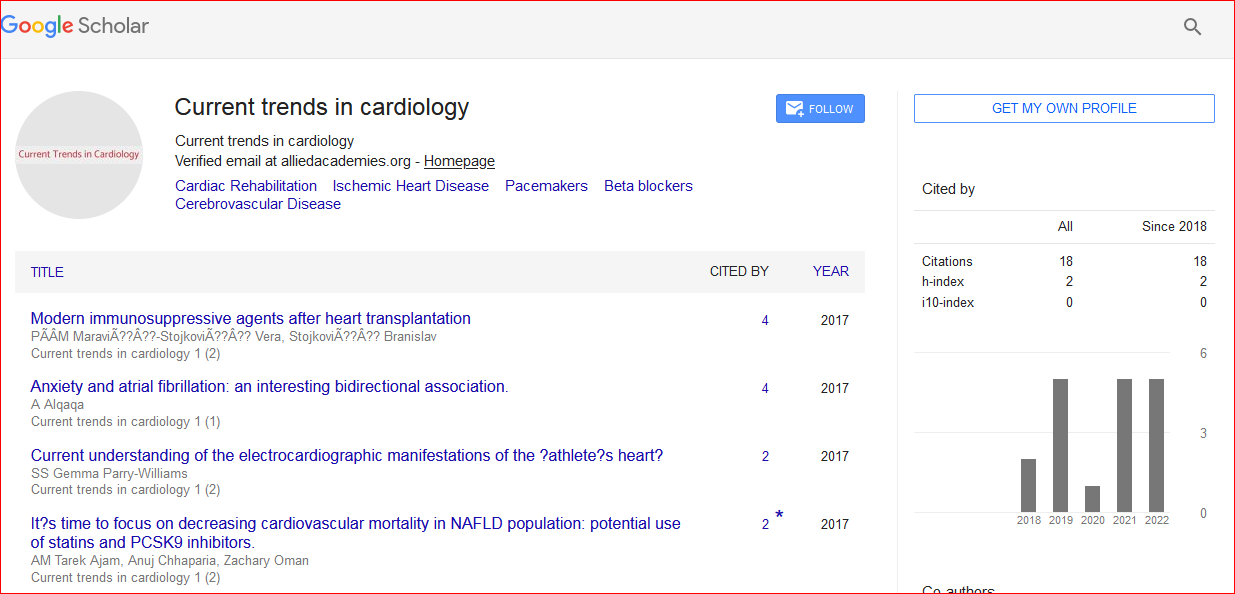Citations Report
Articles published in Current Trends in Cardiology have been cited by esteemed scholars and scientists all around the world.
Current Trends in Cardiology has got h-index 2, which means every article in Current Trends in Cardiology has got 2 average citations.
Following are the list of articles that have cited the articles published in Current Trends in Cardiology.
| 2023 | 2022 | 2021 | 2020 | 2019 | 2018 | 2017 | 2016 | |
|---|---|---|---|---|---|---|---|---|
Total published articles |
111 | 30 | 29 | 32 | 6 | 3 | 15 | 0 |
Conference proceedings |
0 | 12 | 0 | 0 | 20 | 0 | 24 | 0 |
Citations received as per Google Scholar, other indexing platforms and portals |
1 | 5 | 5 | 2 | 5 | 2 | 0 | 0 |
| Journal total citations count | 20 |
| Journal impact factor | 0.17 |
| Journal 5 years impact factor | 0.19 |
| Journal cite score | 0.17 |
| Journal h-index | 2 |
| Journal h-index since 2019 | 2 |
Recurrent tuberculous constrictive pericarditis secondary to pneumo-calcification along the atrio-ventricular groove in post-pericardiectomy with broncho-Epicardial fistula. |
|
| View at Publisher | View at Google Scholar View at Indexing | |
Jariwala P, Kale SS. IHJ Cardiovascular Case Reports (CVCR). |
|
| View at Publisher | View at Google Scholar | |
Response by Soliman et al to Letter Regarding Article, “Derivation and Validation of a Novel Right-Sided Heart Failure Model After Implantation of Continuous Flow Left Ventricular Assist Devices: The EUROMACS (European Registry for Patients With Mechanical Circulatory Support) Right-Sided Heart Failure Risk Score” |
|
| View at Publisher | View at Google Scholar View at Indexing | |
Letter by Aloia Regarding Article, “Derivation and Validation of a Novel Right-Sided Heart Failure Model After Implantation of Continuous Flow Left Ventricular Assist Devices: The EUROMACS (European Registry for Patients with Mechanical Circulatory Support) Right-Sided Heart Failure Risk Score” |
|
| View at Publisher | View at Google Scholar View at Indexing | |
The Effects of Glucagon-Like Peptide-1 Receptor Agonists and Dipeptydilpeptidase-4 Inhibitors on Blood Pressure and Cardiovascular Complications in Diabetes. |
|
| View at Publisher | View at Google Scholar View at Indexing | |
A Case of STEMI Masquerading Brugada Syndrome: Emphasizing the Importance of Clinical Decision Making in Emergencies: |
|
| View at Publisher | View at Google Scholar View at Indexing | |
Mepilex Border Sacrum and Heel Dressings for the Prevention of Pressure Ulcers: A NICE Medical Technology Guidance |
|
| View at Publisher | View at Google Scholar View at Indexing | |
Intrinsic MYH7 expression regulation contributes to tissue level allelic imbalance in hypertrophic cardiomyopathy |
|
| View at Publisher | View at Google Scholar View at Indexing | |
Characterization of the CDAA Diet-Induced Non-alcoholic Steatohepatitis Model: Sex-Specific Differences in Inflammation, Fibrosis, and Cholesterol Metabolism in Middle-Aged Mice. |
|
| View at Publisher | View at Google Scholar View at Indexing | |
Triggers for Atrial Fibrillation: The Role of Anxiety. |
|
| View at Publisher | View at Google Scholar View at Indexing | |
Impact of Yoga on Cardiac Autonomic Function and Arrhythmias |
|
| View at Publisher | View at Google Scholar View at Indexing | |
COVID-19 Suspected myopericarditis without pulmonary involvement |
|
| View at Publisher | View at Google Scholar View at Indexing | |
Shocking truths about implantable cardioverter defibrillator monitoring zones. |
|
| View at Publisher | View at Google Scholar View at Indexing | |
Giα1-Mediated Cardiac Electrophysiological Remodeling and Arrhythmia in Hypertrophic Cardiomyopathy |
|
| View at Publisher | View at Google Scholar View at Indexing | |
Familial hypertrophic cardiomyopathy: Basic concepts and future molecular diagnostics |
|
| View at Publisher | View at Google Scholar View at Indexing | |
Influence of a constitutive increase in myofilament Ca2+-sensitivity on Ca2+-fluxes and contraction of mouse heart ventricular myocytes |
|
| View at Publisher | View at Google Scholar View at Indexing | |
The value of changes in QRS width and in ST-T segment during exercise test in hypertrophic cardiomyopathy for identification of associated coronary artery disease. |
|
| View at Publisher | View at Google Scholar View at Indexing | |
Exercise, heart and health. |
|
| View at Publisher | View at Google Scholar View at Indexing | |
Myocardial hypertrophy is improved with berberine treatment via long non?coding RNA MIAT?mediated autophagy |
|
| View at Publisher | View at Google Scholar View at Indexing | |
